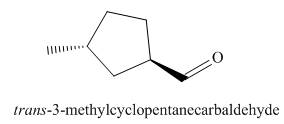
Concept explainers
(a)
Interpretation: The structure corresponding to the given IUPAC name is to be stated.
Concept introduction: One should follow the given steps to derive the structure of an
Answer to Problem 21.4P
The structure corresponding to the given IUPAC name is,

Explanation of Solution
The IUPAC name of the given compound is
One should follow the given steps to derive the structure of an aldehyde from its IUPAC name. The first step is finding of longest parent chain that contains an aldehyde group. The second step is changing of -e ending of the parent alkane to the suffix -al. However, when an aldehyde
The given IUPAC name suggests the presence of
Thus, the structure corresponding to the given IUPAC name is,

Figure 1
The structure corresponding to the given IUPAC name is shown in Figure 1.
(b)
Interpretation: The structure corresponding to the given IUPAC name is to be stated.
Concept introduction: One should follow the given steps to derive the structure of an aldehyde from its IUPAC name. The first step is finding of longest parent chain that contains an aldehyde group. The second step is changing of -e ending of the parent alkane to the suffix -al. However, when an aldehyde
Answer to Problem 21.4P
The structure corresponding to the given IUPAC name is,

Explanation of Solution
The IUPAC name of the given compound is
One should follow the given steps to derive the structure of an aldehyde from its IUPAC name. The first step is finding of longest parent chain that contains an aldehyde group. The second step is changing of -e ending of the parent alkane to the suffix -al. However, when an aldehyde
The given IUPAC name suggests the presence of

Figure 2
The structure corresponding to the given IUPAC name is shown in Figure 2.
(c)
Interpretation: The structure corresponding to the given IUPAC name is to be stated.
Concept introduction: One should follow the given steps to derive the structure of an aldehyde from its IUPAC name. The first step is finding of longest parent chain that contains an aldehyde group. The second step is changing of -e ending of the parent alkane to the suffix -al. However, when an aldehyde
Answer to Problem 21.4P
The structure corresponding to the given IUPAC name is,

Explanation of Solution
The IUPAC name of the given compound is
One should follow the given steps to derive the structure of an aldehyde from its IUPAC name. The first step is finding of longest parent chain that contains an aldehyde group. The second step is changing of -e ending of the parent alkane to the suffix -al. However, when an aldehyde
The given IUPAC name suggests the presence of

Figure 3
The structure corresponding to the given IUPAC name is shown in Figure 3.
(d)
Interpretation: The structure corresponding to the given IUPAC name is to be stated.
Concept introduction: One should follow the given steps to derive the structure of an aldehyde from its IUPAC name. The first step is finding of longest parent chain that contains an aldehyde group. The second step is changing of -e ending of the parent alkane to the suffix -al. However, when an aldehyde
Answer to Problem 21.4P
The structure corresponding to the given IUPAC name is,

Explanation of Solution
The IUPAC name of the given compound is
One should follow the given steps to derive the structure of an aldehyde from its IUPAC name. The first step is finding of longest parent chain that contains an aldehyde group. The second step is changing of -e ending of the parent alkane to the suffix -al. However, when an aldehyde
The given IUPAC name suggests the presence of
Thus, the structure corresponding to the given IUPAC name is,

Figure 4
The structure corresponding to the given IUPAC name is shown in Figure 4.
Want to see more full solutions like this?
Chapter 21 Solutions
Organic Chemistry
- Draw the products (including stereoisomers) formed when benzaldehyde (C6H5CHO) is treated with each Wittig reagent.arrow_forward2. Draw the reaction scheme in ChemDraw depicting Strecker aldehyde starting from α-dicarbonyl. Include general reactants and by-products as necessary.arrow_forwardExplain Addition of Alcohols—Acetal Formation ?arrow_forward
- Draw the products formed when D-altrose is treated with each reagent. a. (CH3)2CHOH, HCl b. NaBH4, CH3OH c. Br2, H2O d. HNO3, H2O e. [1] NH2OH; [2] (CH3CO)2O, NaOCOCH3; [3] NaOCH3 f. [1] NaCN, HCl; [2] H2, Pd-BaSO4; [3] H3O+ g. CH3I, Ag2O h. C6H5CH2NH2, mild H+arrow_forwardDraw the product formed when (CH3)2CHOH is treated with each reagent. a.SOCl2, pyridine b. TsCl, pyridine c.H2SO4 d.HBr e.PBr3, then NaCN f.POCl3, pyridinearrow_forwardDraw the product formed when (CH3)2CHOH is treated with each reagent. a. SOCl2, pyridine b. TsCl, pyridine c. H2SO4 d. HBr e. PBr3, then NaCN f. POCl3, pyridinearrow_forward
- How can pentan-2-one be converted to each compound?arrow_forward(a) Give the IUPAC name for A and B. (b) Draw the product formed when A or B is treated with each reagent: [1] NaBH4, CH3OH; [2] CH3MgBr, then H2O; [3] Ph3P = CHOCH3; [4] CH3CH2CH2NH2, mild acid; [5] HOCH2CH2CH2OH, H+.arrow_forwardPlease give IUPAC names and R/S and E/Z designations for each molecule.arrow_forward
 Organic Chemistry: A Guided InquiryChemistryISBN:9780618974122Author:Andrei StraumanisPublisher:Cengage Learning
Organic Chemistry: A Guided InquiryChemistryISBN:9780618974122Author:Andrei StraumanisPublisher:Cengage Learning
